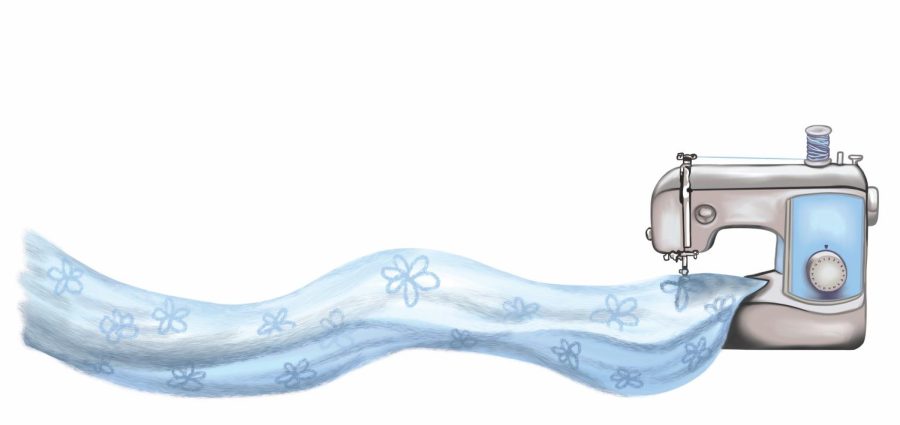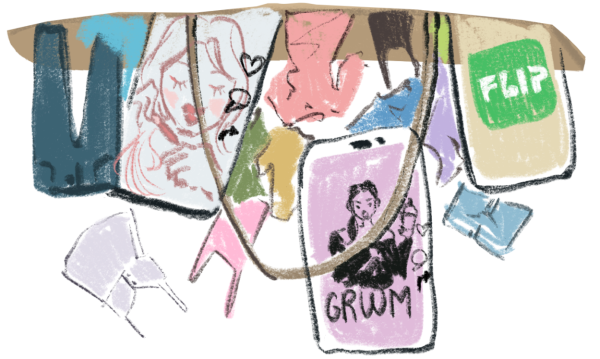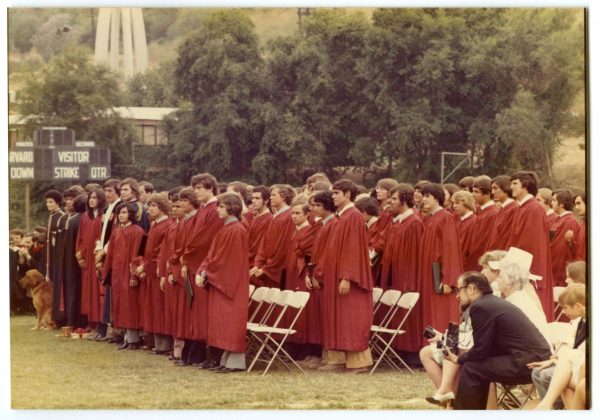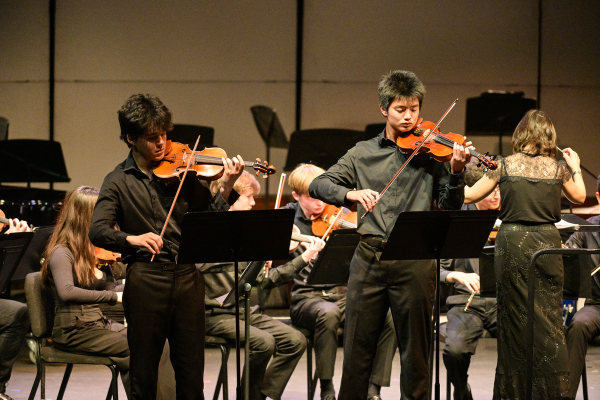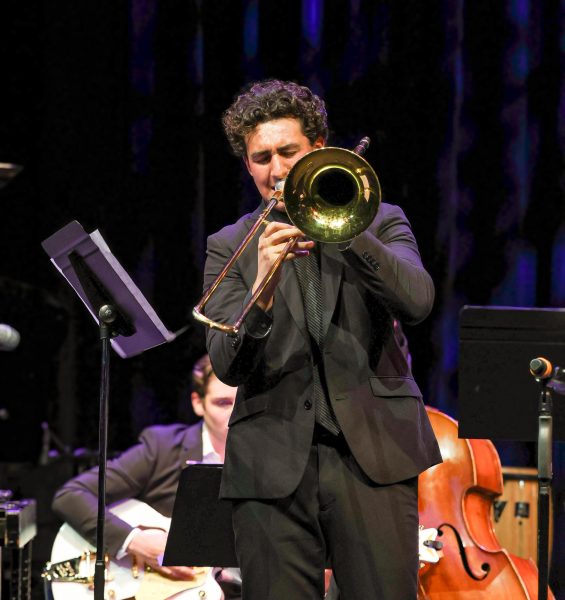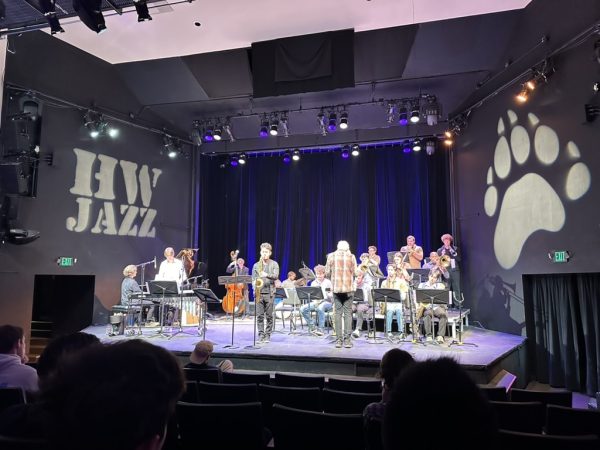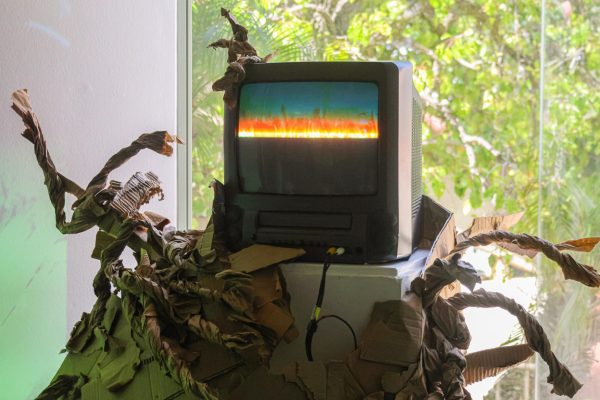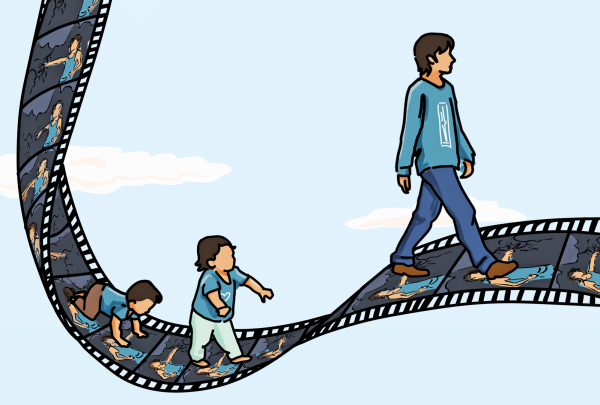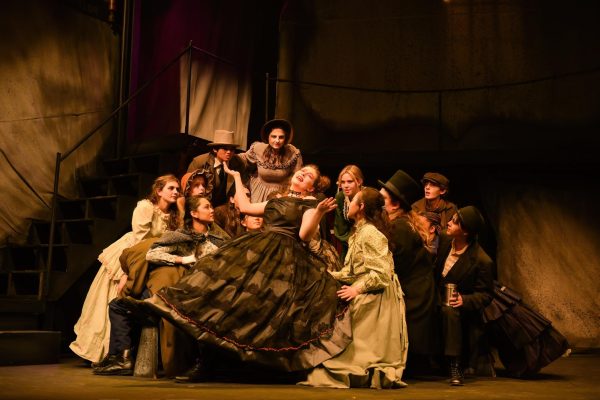Designers in Action
March 23, 2022
Sitting in front of a wall covered in magazine scraps, sketches and patterns, Paisley Kandler ’22 traced over her fashion designs on Procreate, a digital illustration app. A sewing machine hummed in the background, and a group of students stood around a mannequin, pinning fabric to form the shape of a dress. The Basic Sewing and Costume Techniques class had been working on costumes for the upper school winter musical “Spring Awakening” throughout the semester with the goal of enhancing the storyline through the performers’ clothing.
Kandler said although some people overlook costume design as a mere behind-the-scenes theater process, she said she believes there is more to it than meets the eye. She said that costume design is an art form that can be used to express ideas, themes and feelings.
“Students might assume that costume designers mainly work on costumes for plays and musicals,” Kandler said. “While some do, the point of the class is to explore conceptualization. The intro class focuses on coming up with costumes based on real-world things, such as music or the scents of different spices.”
Basic Sewing and Costume Techniques student Henry Pokress ’23 said fashion is more than just visual art and can be used to tell a story.
“Metaphors can help you choose fabric and certain design techniques,” Pokress said. “For example, in ‘Spring Awakening,’ instead of dressing up the adult characters in typical costumes of the time period, the designers went with a devilish look to convey how the kids in the play saw their parents.”
Barbara Chen ’23 said she was inspired to join the Basic Sewing and Costume Techniques class, run by Performing Arts Teacher Lisa Peters, to gain artistic skills and branch out into different mediums. The class explores different methods of costume design, and along with other students, Chen works behind-the-scenes to create costumes for the school’s on-stage productions. She said this process allows her to enjoy theater without the pressure of acting in front of a live audience.
“I’ve always been interested in character design,” Chen said. “I took the [Basic Sewing and Costume Techniques] class to gain more drawing skills. I also like theater, but I don’t want to physically participate on stage, so I think [making costumes] is a good balance.”
Chen said although some students may not be familiar with the costume design class, the course helped her pursue creative, collaborative projects and gain new experiences.
“A lot of people who come into the costume room are surprised because they did not even know that this room existed,” Chen said. “I think more people should learn about [the class] because you can make a lot of cool projects. Right now, I am working on a dress with two classmates, which we made using sewing patterns and the instructions that go with it.”
Peters said she strives to teach students how to express themselves and their ideas through wearable mediums.
“I teach students about the art and craft of costume design,” Peters said. “The class involves the principles of design and how to use them to create an effective costume, break down the script and form a cohesive group of characters that tell a story.”
Peters said her favorite part of teaching costume design is watching students gain new experiences and create practical, wearable products.
“I love working with students and seeing their lightbulb moment when they learn a tangible skill,” Peters said. “It’s fun to see them sit down and do something they have never done before. For example, when my students make pajamas, they create something wearable for the first time, and it excites them.”
Likewise, Maddy James ’23 said her favorite part of the Basic Sewing and Costume Techniques course is the feeling of completing a project. She said it is gratifying to use fabric and sewing materials to make a practical wardrobe item.
“I like being able to take something and turn it into something completely different,” James said. “There’s definitely a lot of effort that goes into each project, but at the end of the day, I am able to create things, which is very satisfying. In academic courses, you get a letter grade in return, which does not feel as rewarding.”
James said while she enjoys the feeling of completing a project, the art of costume design requires more effort than she expected. She said even though she is occasionally discouraged by mistakes, trial and error make for a strong final product.
“Before I got into fashion design, I just thought it was cool, but there was so much more behind it,” James said. “Whether you are altering a pattern or creating something from scratch, it could take months just to plan the scaling and sizing of the project. You have to put a lot of consideration into it first.”
Like James, Peters said the work that goes into costume design should be appreciated because of the necessary planning and collaboration. She said costume design can be unpredictable and requires a lot of perseverance to complete projects.
“Even in a small-scale production, a lot of thought and preparation is required,” Peters said. “Sometimes, you just get to a situation where something is not working, and you have to rethink it. Going back to the beginning and starting again can be frustrating, but sometimes leads to a better solution.”
Ofek Levy ’23 said the school’s costume process for plays and musicals involves a lot of brainstorming, editing and collaboration to ensure the outfits are cohesive.
“Once the actors are recruited, the costume designers [get involved],” Levy said. “We start sketching designs and breaking down what we would like to fit a certain character in terms of mood and theme. Then, we look at the designs done for the other actors to see how they compare. [Finally], we make the costumes match based on whether we want to emphasize the similarity or difference.”
Kandler said although her process involves more digital work than hands-on sewing, her preparation involves researching different types of fashion and design techniques to construct an effective costume.
“I start with a lot of research, particularly if my costumes are based on a book or folktales,” Kandler said. “Then, I draw the sketches in a notebook and render them in Procreate. The digital rendering takes the most time and makes up three-and-a-half months of my [most recent] project.”
Pokress said he likes the collaborative environment that the course provides. Additionally, he said he is able to bond with other students through a shared interest in costume design.
“My favorite part about the class is being able to see what the other kids in the class are working on,” Pokress said. “I think it is less competitive than other classes, and you can work with other people to express your ideas. Right now, I’m working with another classmate to make a spring outfit.”
Levy said a fundamental part of fashion design is finding themes within everyday objects. He said he recently completed a project based on succulent plants, in which he drew inspiration from the natural world and its patterns.
“I did a collection [inspired by] succulents, and one of the big things about succulents is their symmetry,” Levy said. “However, a lot of times, succulents are also asymmetrical. Comparing and contrasting those two ideas was central to my collection because I wanted to create this idea of balance and repetition that creates really strong clothing and art.”
Pokress said while he is not completely sure about his plans for after high school, he wants to continue pursuing fashion design as a method of creative expression.
“I definitely want to do [fashion design] after high school,” Pokress said. “I feel like I would not really be [myself] if I did not express my creative side. I would like to learn more about fashion and explore it further, whether it’s as a career or a hobby.”
Despite the amount of work and planning that goes into costume design, James said her final products make her feel rewarded for her efforts.
“It takes bravery to take on a large project,” James said. “There’s so much more to [fashion design] than just pretty garments, but if you take the time to prepare up front, then the end result will be much, much better and very gratifying.”































